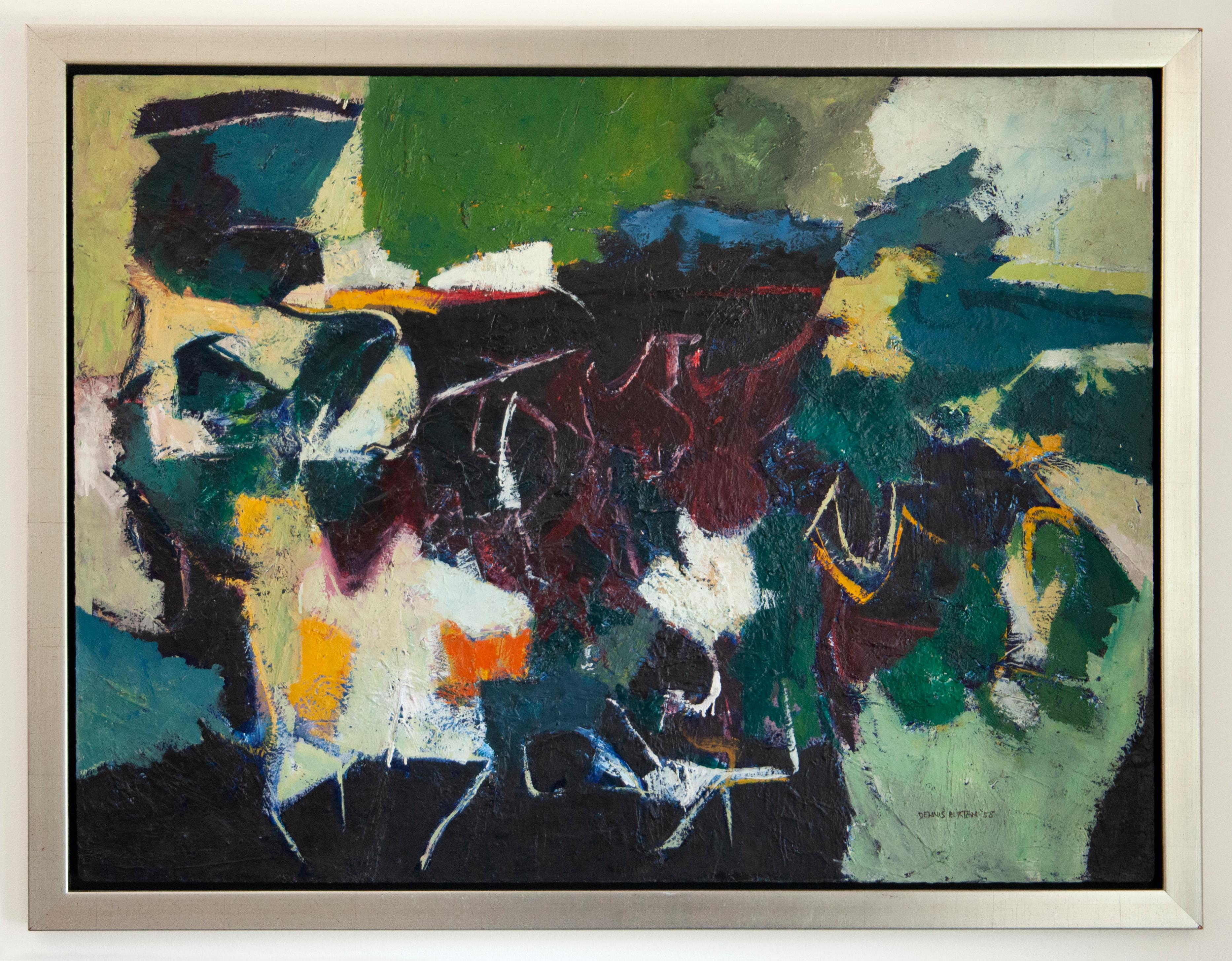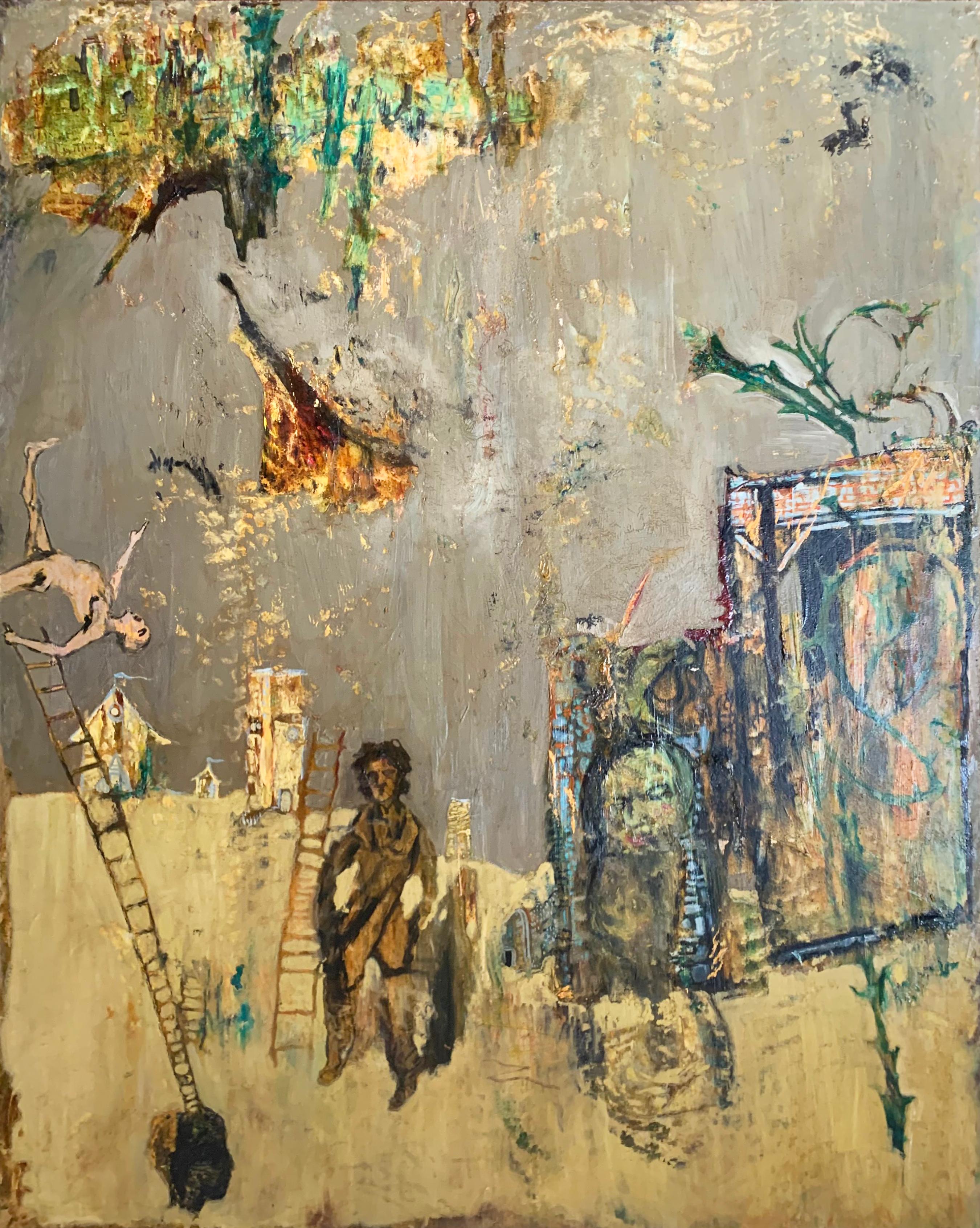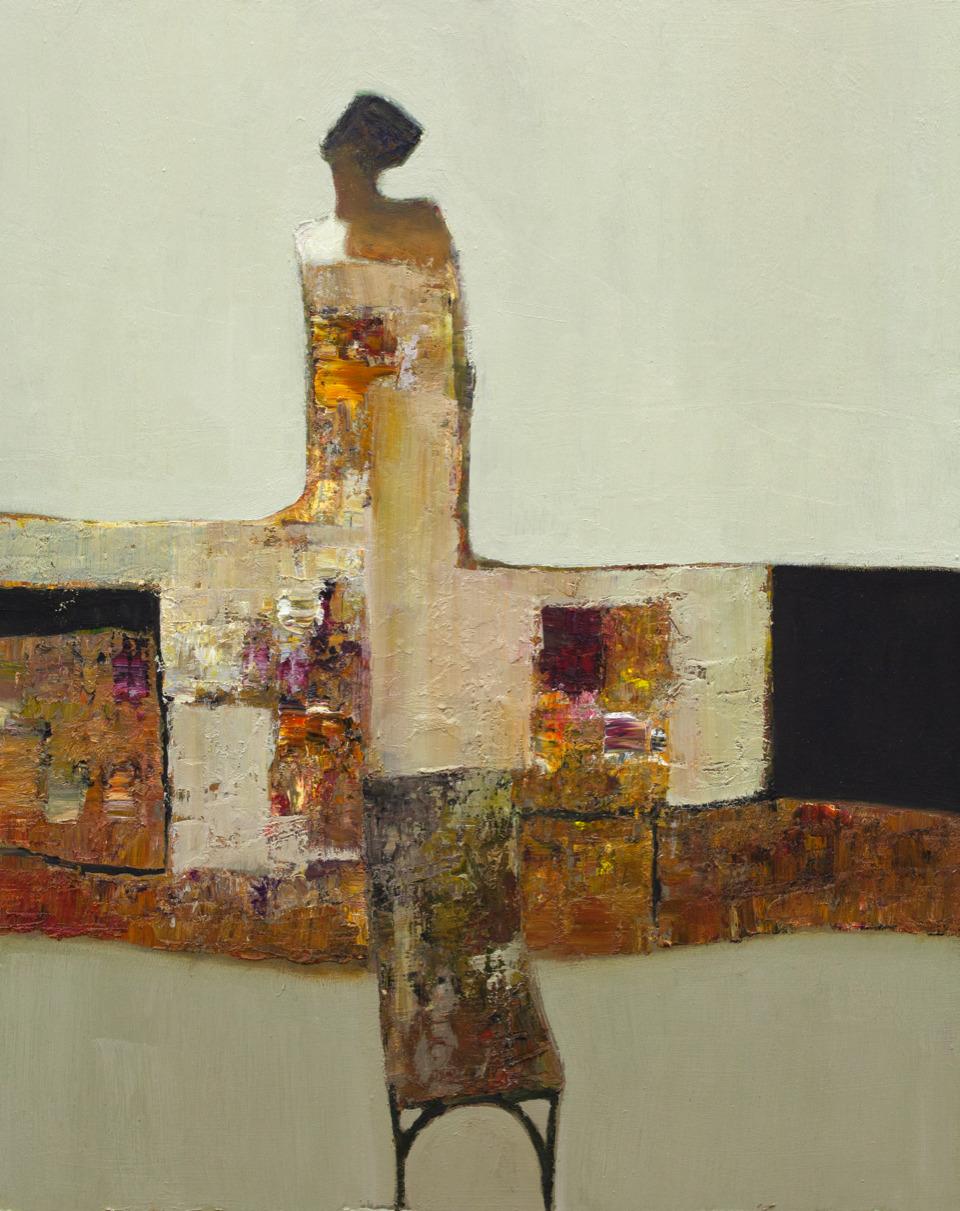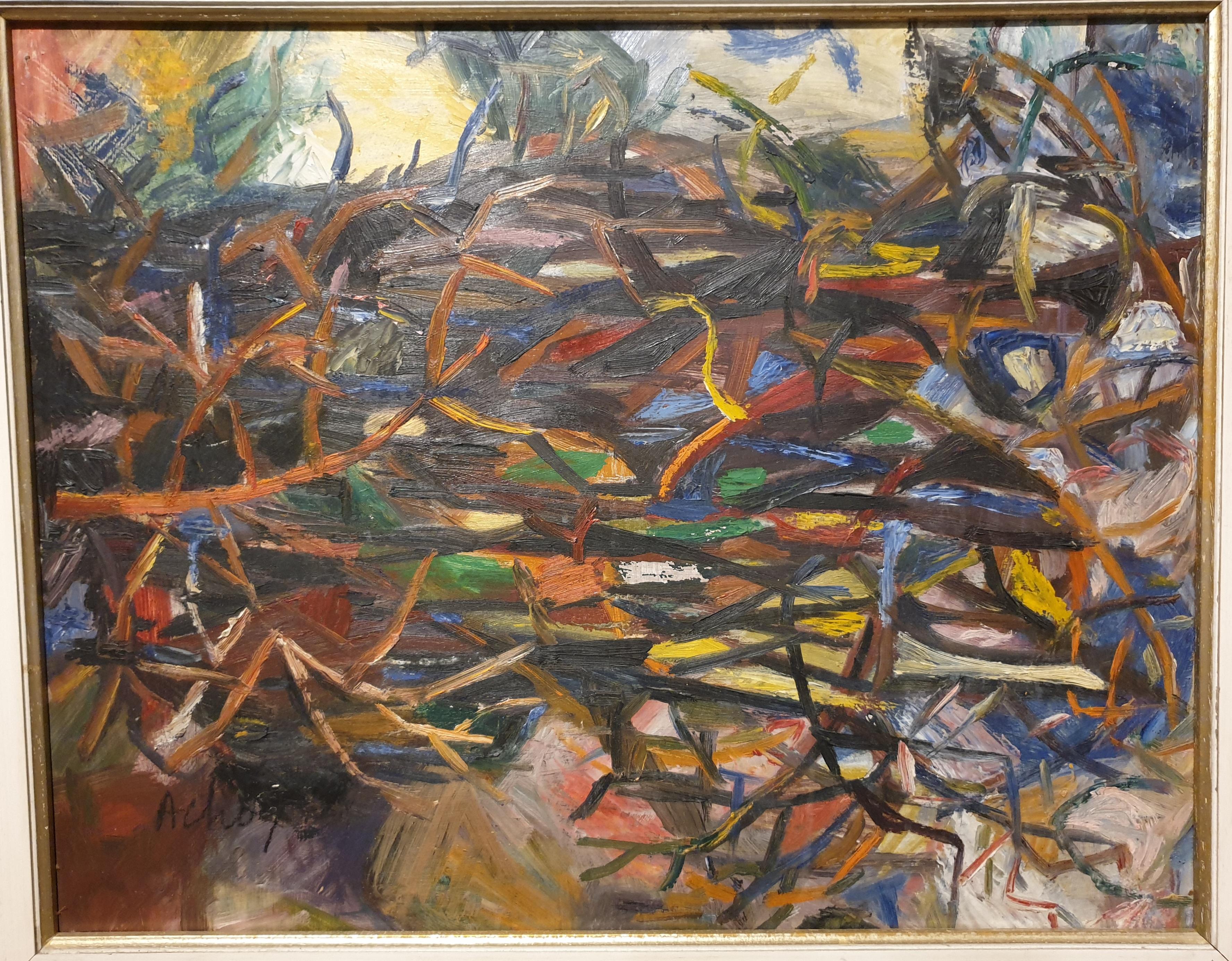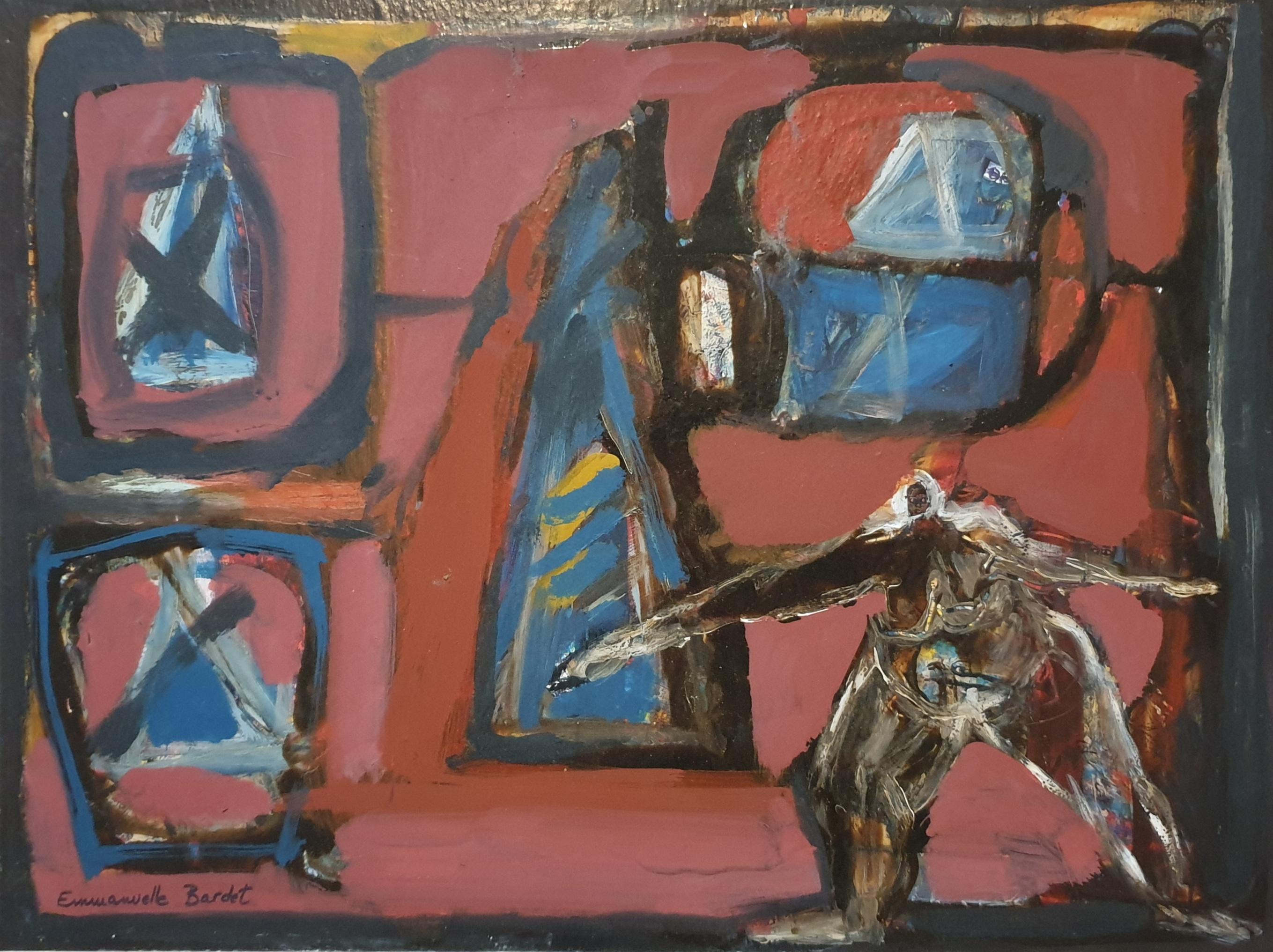Items Similar to 1950s Abstract Expressionist Oil Painting, Blue Brown Orange Sage Green
Want more images or videos?
Request additional images or videos from the seller
1 of 14
Charles Ragland Bunnell1950s Abstract Expressionist Oil Painting, Blue Brown Orange Sage Green1955
1955
About the Item
Abstract expressionist oil painting on board from 1955 by Charles Bunnell. Abstract shapes in layers of sage green, light blue, brown, gold, and black. Presented in a custom frame, outer dimensions measure 16 ¼ x 20 ¼ inches. Image size is 16 x 20 inches.
Provenance: Estate of the artist, Charles Ragland Bunnell
Painting is in good condition - please contact us for a detailed condition report.
About the Artsit:
Born 1897
Died 1968
Artist and teacher, Charles ("Charlie") Bunnell worked in a variety of styles throughout his career because as an artist he believed, "I’ve got to paint a thousand different ways. I don’t paint any one way." At different times he did representational landscapes while concurrently involved with semi- or completely abstract imagery. He was one of a relatively small number of artists in Colorado successfully incorporating into their work the new trends emanating from New York and Europe after World War II. During his lifetime he generally did not attract a great deal of critical attention from museums, critics and academia. However, he personally experienced a highpoint in his career when Katherine Kuh, curator at the Art Institute of Chicago, personally chose one of his paintings – Why? - for its large exhibition of several hundred examples of abstract and surrealist art held in 1947-48, subsequently including it among the fifty pieces selected for a traveling show to ten other American museums.
An only child, Bunnell developed his love of art at a young age through frequent drawing and political cartooning. In high school he was interested in baseball and golf and also was the tennis champion for Westport High School in Kansas City. Following graduation, his father moved the family to Denver, Colorado, in 1916 for a better-paying bookkeeping job, before relocating the following year to Colorado Springs to work for local businessman, Edmond C. van Diest, President of the Western Public Service Company and the Colorado Concrete Company. Bunnell would spend almost all of his adult life in Colorado Springs.
In 1918 he enlisted in the United States Army, serving in the 62nd Infantry Regiment through the end of World War I. Returning home with a 10% disability, he joined the Zebulon Pike Post No. 1 of the Disabled American Veterans Association and in 1921 used the benefits from his disability to attend a class in commercial art design conducted under a government program in Colorado Springs. The following year he transferred to the Broadmoor Art Academy (founded in 1919) where he studied with William Potter and in 1923 with Birger Sandzén. Sandzén’s influence is reflected in Bunnell’s untitled Colorado landscape (1925) with a bright blue-rose palette.
For several years thereafter Bunnell worked independently until returning to the Broadmoor Art Academy to study in 1927-28 with Ernest Lawson, who previously taught at the Kansas City Art Institute where Bunnell himself later taught in the summers of 1929-1930 and in 1940-41. Lawson, a landscapist and colorist, was known for his early twentieth-century connection with "The Eight" in New York, a group of forward-looking painters including Robert Henri and John Sloan whose subject matter combined a modernist style with urban-based realism. Bunnell, who won first-place awards in Lawson’s landscapes classes at the Academy, was promoted to his assistant instructor for the figure classes in the 1928-29 winter term. Lawson, who painted in what New York critic James Huneker termed a "crushed jewel" technique, enjoyed additional recognition as a member of the Committee on Foreign Exhibits that helped organize the landmark New York Armory Exhibition in 1913 in which Lawson showed and which introduced European avant-garde art to the American public.
As noted in his 1964 interview for the Archives of American Art in Washington, DC, Bunnell learned the most about his teacher’s use of color by talking with him about it over Scotch as his assistant instructor. "Believe me," Bunnell later said, "[Ernie] knew color, one of the few Americans that did." His association with Lawson resulted in local scenes of Pikes Peak, Eleven Mile Canyon, the Gold Cycle Mine near Colorado City and other similar sites, employing built up pigments that allowed the surfaces of his canvases to shimmer with color and light. (Eleven Mile Canyon was shown in the annual juried show at the Carnegie Institute in Pittsburgh in 1928, an early recognition of his talent outside of Colorado.) At the same time, he animated his scenes of Colorado Springs locales by defining the image shapes with color and line as demonstrated in Contrasts (1929). Included in the Midwestern Artists’ Exhibition in Kansas City in 1929, it earned him the gold medal of the Kansas City Art Institute, auguring his career as a professional artist.
In the 1930s Bunnell used the oil, watercolor and lithography media to create a mini-genre of Colorado’s old mining towns and mills, subject matter spurned by many local artists at the time in favor of grand mountain scenery. In contrast to his earlier images, these newer ones – both daytime and nocturnal -- such as Blue Bird Mine essentially are form studies. The conical, square and rectangular shapes of the buildings and other structures are placed in the stark, undulating terrain of the mountains and valleys devoid of any vegetation or human presence. In the mid-1930s he also used the same approach in his monochromatic lithographs titled Evolution, Late Evening, K.C. (Kansas City) and The Mill, continuing it into the next decade with his oil painting, Pikes Peak (1942).
During the early 1930s he studied for a time with Boardman Robinson, director of the Broadmoor Art Academy and its successor institution, the Colorado Springs Fine Arts Center from 1930 to 1947. In 1934 Robinson gave him the mural commission under the Public Works of Art Project (PWAP) for West Junior High School in Colorado Springs, his first involvement in one of several New Deal art projects employing artists during the Great Depression. He thereafter assisted Frank Mechau with his mural for the Colorado Springs Post Office and Mechau, in turn, helped get him transferred to the Treasury Relief Art Project (TRAP) that commissioned work from artists to decorate existing and new federal buildings throughout the country. When it closed down due to lack of funds, Bunnell participated in the Federal Art Project (FAP) for which he did easel paintings in the proscribed American Scene painting style.
At the same time, he also began working on his own in a non-regionalist style that evolved into full-blown abstraction by the early 1950s. One indication of the new direction, a drawing - Evolution of Art (1937), shows three warheads breaking down various barriers in their path to make way for new developments in art. It may have been inspired by a traveling exhibition of abstract art which he saw at the Colorado Springs Fine Arts Center in 1936. Another shift toward abstraction was his Black and Blue watercolor series of eighty-three ink and watercolors begun in 1936 and pursued through the 1940s.
As described by Dord Fitz, Bunnell’s friend, gallery owner and dealer based in Amarillo, Texas, the Black and Blue Series "presents a world of the spirit where all men are one… [Bunnell] carries the spectator into a spiritual realm which remains undisturbed by the colossal misunderstandings which plague a life dominated by material and physical things." Fitz also noted that the series blends "the various feelings concerning theories of Existence – Buddha, Christ, Lao Tze, Confucius and Mohammed. All become One." The series mirrors Bunnell’s personal spiritual journey extending into the late 1950s reflected in his art. The loss of his 10-year old son, Lee, in 1938, and the death and destruction caused by World War II also found expression in the series, as well as in his moody surrealist pieces from the mid-to-late 1940s, such as the Bird of Doom watercolors and a set of the seven deadly sins.
The geometric shapes of his earlier representational work reappeared in the 1950s in the form of roughly- rendered rectangles, squares and triangles in various sizes and colors in his pure abstractions, such as an untitled composition (1951) of small, massed geometric shapes in an impasto surface highlighted in bright red, blue and green. By mid-decade his palette became a little more subdued with larger shapes dominating the canvas, as in Artist and His Pictures (1955), and Progression (1956) with its superimposed clusters of smaller geometric shapes. These and other similar abstract paintings constitute the highlight of his career during which, in the words of Al Kochka -- curator of Bunnell’s posthumous retrospective (1987) at the Amarillo Art Center – "he never ceased to experiment and expand his visual language."
In the artist’s statement for the catalog of his exhibition at the Colorado Springs Fine Arts Center in 1956, Bunnell said of his work: "Art to me is a search: in other words, a way of living…I have painted for thirty-five years going through many phases from realism and portraiture to, I feel, advanced modern concepts, where the observer can, by looking at my paintings, become a creator as well as I. In other words, each viewer can see what he feels in my work."
Bunnell continued to teach throughout most of his career. Having briefly taught art classes toward the end of the Federal Art Project during the Depression era, he began conducting classes in his own Colorado Springs studio in 1949. He continued mentoring new artists until the last years of his life before succumbing to emphysema. In the 1950s he was one of the artists Dord Fitz attracted to teach and display his work in Amarillo, along with Louise Nevelson, James Brooks, Leon Polk Smith and Elaine de Kooning, among others. In 1960 de Kooning painted Bunnell’s portrait, now in a private collection.
Solo Shows: Kansas City Art Institute (1930); New Mexico Museum of Art-Santa Fe (1947); University of Illinois-Urbana (1948); University of Kentucky, Lexington (1949); Taos Gallery-New Mexico (1951); Carl Barnett Galleries-Dallas (1952); The Antlers Gallery-Colorado Springs (1952); Bodley Gallery-New York (1955); Haigh Gallery-Denver (1955); Colorado Springs Fine Arts Center (1956); Dord Fitz Gallery-Amarillo, TX (1956, 1957, 1959. 1969-retrospective).
Group Exhibitions: Colorado State Fair (1928, first prize); Carnegie International-Pittsburgh (1928); Denver Art Museum (1928, 1947,1956); Artists Midwestern Exhibition-Kansas City, MO (1929, gold medal-first prize); Colorado Springs Fine Arts Center-show with Archie Musick sponsored by Randall Davey (1930); World’s Fair Art Exhibition-San Francisco (1939); Art Institute of Chicago-"Abstract and Surrealist Art" (1947-48); Colorado Springs Fine Arts Center-"Artists West of the Mississippi" (1936, 1941, 1946, 1948, 1953, 1959); Mid-America Annual, Kansas City, MO (1958); First Provincetown Festival-MA (1958); Southwestern Annual-Santa Fe (1957-58).
©Stan Cuba for David Cook Galleries, LLC
- Creator:Charles Ragland Bunnell (1897-1968, American)
- Creation Year:1955
- Dimensions:Height: 16.25 in (41.28 cm)Width: 20 in (50.8 cm)Depth: 1 in (2.54 cm)
- Medium:
- Movement & Style:
- Period:
- Framing:Frame IncludedFraming Options Available
- Condition:
- Gallery Location:Denver, CO
- Reference Number:
About the Seller
5.0
Platinum Seller
These expertly vetted sellers are 1stDibs' most experienced sellers and are rated highest by our customers.
Established in 1979
1stDibs seller since 2013
264 sales on 1stDibs
Typical response time: 5 hours
- ShippingRetrieving quote...Ships From: Denver, CO
- Return PolicyA return for this item may be initiated within 7 days of delivery.
More From This SellerView All
- 1950s Abstract Expressionist Composition, Mid Century Oil Painting, Blue YellowBy Charles Ragland BunnellLocated in Denver, COOriginal 1958 mid-century modern oil painting by Charles Bunnell (1897-1968), abstract expressionist composition in colors of Yellow, Blue, Teal, Green, Gray, Orange, Red & White, signed and dated lower right. Presented in a vintage gold tone frame, outer dimensions measure 34 ¾ x 28 ¾ x 1 ½ inches. Image size is 29 ¾ x 23 ¾ inches. Painting is clean and in very good vintage condition - please contact us for a complete condition report. Provenance: Estate of Charles Ragland Bunnell Expedited and international shipping is available - please contact us for a quote. About the Artist: Charles Bunnell developed a love for art as a child in Kansas City, Missouri. Around 1915, Bunnell moved with his family to Colorado Springs, Colorado. He served in World War I and later used his GI Training to study at the Broadmoor Art Academy (later renamed the Colorado Springs Fine Arts Center) during 1922 and 1923. In 1922, he married fellow student, Laura Palmer...Category
1950s Abstract Expressionist Abstract Paintings
MaterialsOil, Board
- Stone Quarry, 1960s Abstract Acrylic Paper Collage by Margo Hoff, Purple GrayBy Margo HoffLocated in Denver, COAn original signed framed abstract expressionist painting by mid-century modern Chicago woman artist, Margo Hoff (1910-2008), "Stone Quarry" was created using acrylic, crayon and paper collage on board in shades of purple, blue, brown, white and black. Presented in a custom frame, outer dimensions measure 48 ½ x 40 ½ x 1 ¾ inches. Image size is 48 x 40 inches. Provenance: Estate of the artist, Margo Hoff About the Artist: A prolific artist, Margo Hoff’s exquisite style evolved throughout her career yet was always rooted in the events, people, and places in her life. The human experience was her soul focus, expressed through her eyes alone. Born in 1910 in Tulsa, Oklahoma, Hoff began creating white-clay animals at a young age, giving them to her friends and family. At eleven she contracted typhoid fever and was bedridden for a summer. During her convalescence, she drew and made cutouts, and it was during this time that her bold, artistic imagination came alive. She began formal art training in high school and continued her education at the University of Oklahoma, Tulsa. In 1933 she moved to Chicago and attended the National Academy of Art and the School of the Art Institute of Chicago. Between 1933 and 1960—her Chicago years—Hoff’s works was deeply rooted in a figurative, regionalist style. She often used elements of magical realism, and many of her paintings have dreamlike qualities. As a child she learned about color by grinding down rocks, plants, and berries. Her color pallet during the Chicago years is indicative of her early-life color experimentation as she consistently used warm, earth tones in her work. Hoff was a born adventurer and traveled extensively. She lived, worked, taught, and painted in Europe, Mexico, Beirut, Lebanon, Uganda, Brazil, and China. She also showed at the Denver Art Museum’s Annual Western Exhibitions in 1952-54, 56, and 57. In 1957 she showed along side Colorado modernist Vance Kirkland at the Denver Art Museum’s exhibition, Man's Conquest of Space. What was once a focus on the representational, her work began to change after 1957 when she saw Sputnik in its orbit around Earth. At that moment, feet firmly placed on the ground, she was able to imagine herself in space, looking down from the cosmos, and what she saw was an abstracted world. She then had the opportunity to peer into an electron microscope where once again she was looking down into what seemed to be a realm of pure abstraction. These two events profoundly changed her perspective and she began to move from figural painting to abstract, geometric collage. In 1960, Hoff moved to New York City and she began creating collages. Placing the canvas on the ground, and working from all sides, she used strips of painted paper and tissue—and later painted pieces of canvas—glued onto the canvas surface, building layer upon layer, shape against shape, “action of color next to stillness of color.” She believed these simplified, abstracted forms held the spirit of the subject in the same way poetry reduces words to their essence. These pieces range from aerial cityscapes, to dancers in motions, to flora...Category
1960s Abstract Expressionist Mixed Media
MaterialsAcrylic, Paper, Crayon, Mixed Media, Board
- Mid Century Modern Abstract Oil Painting by Werner Drewes, Green Blue Red YellowBy Werner DrewesLocated in Denver, COAbstract oil on canvas painting by Werner Drewes painted in vibrant shades of green, blue, and red from 1944. Signed by the artist in the lower right corner of the canvas. Presented ...Category
20th Century Abstract Expressionist Abstract Paintings
MaterialsOil
- Crystal, Series #3 Ros, 1960 Abstract Collage Painting in Purple & Pink TonesBy Margo HoffLocated in Denver, COMid-century modern abstract painting of crystal formations by Margo Hoff (1910-2008) created with acrylic and canvas collage in purple and pink coloring. Wrapped canvas is ready to hang, outer dimensions measure 49 x 49 x 1 ¼ inches. Provenance: Estate of the Artist, Margo Hoff About the Artist: Born Oklahoma 1910 Died New York 2008 A prolific artist, Margo Hoff’s exquisite style evolved throughout her career yet was always rooted in the events, people, and places in her life. The human experience was her sole focus, expressed through her eyes alone. Born in 1910 in Tulsa, Oklahoma, Hoff began creating white-clay animals at a young age, giving them to her friends and family. At eleven she contracted typhoid fever and was bedridden for a summer. During her convalescence, she drew and made cutouts, and it was during this time that her bold, artistic imagination came alive. She began formal art training in high school and continued her education at the University of Oklahoma, Tulsa. In 1933 she moved to Chicago and attended the National Academy of Art and the School of the Art Institute of Chicago. Between 1933 and 1960—her Chicago years—Hoff’s works was deeply rooted in a figurative, regionalist style. She often used elements of magical realism, and many of her paintings have dreamlike qualities. As a child she learned about color by grinding down rocks, plants, and berries. Her color pallet during the Chicago years is indicative of her early-life color experimentation as she consistently used warm, earth tones in her work. Hoff was a born adventurer and traveled extensively. She lived, worked, taught, and painted in Europe, Mexico, Lebanon, Uganda, Brazil, and China. She also showed at the Denver Art Museum’s Annual Western Exhibitions in 1952-54, 56, and 57. In 1957 she showed along side Colorado modernist Vance Kirkland at the Denver Art Museum’s exhibition, Man's Conquest of Space. What was once a focus on the representational, her work began to change after 1957 when she saw Sputnik in its orbit around Earth. At that moment, feet firmly placed on the ground, she was able to imagine herself in space, looking down from the cosmos, and what she saw was an abstracted world. She then had the opportunity to peer into an electron microscope where once again she was looking down into what seemed to be a realm of pure abstraction. These two events profoundly changed her perspective and she began to move from figural painting to abstract, geometric collage. In 1960, Hoff moved to New York City and she began creating collages. Placing the canvas on the ground, and working from all sides, she used strips of painted paper and tissue—and later painted pieces of canvas—glued onto the canvas surface, building layer upon layer, shape against shape, “action of color next to stillness of color.” She believed these simplified, abstracted forms held the spirit of the subject in the same way poetry reduces words to their essence. These pieces range from aerial cityscapes, to dancers in motions, to flora...Category
1960s Abstract Expressionist Paintings
MaterialsAcrylic, Mixed Media, Canvas, Oil
- 1950s Framed Abstract Expressionist Oil Painting, Mid Century Modern, Green RedBy Charles Ragland BunnellLocated in Denver, COVintage 1950s mid century modern abstract expressionist painting by Colorado artist, Charles Ragland Bunnell in shades of red, green, white, and black. Presented in the artist's orig...Category
1950s Abstract Expressionist Abstract Paintings
MaterialsOil, Wood
- 1950s Abstract Oil Painting, Framed Mid Century Modern Painting Blue Black WhiteBy Paul Kauver SmithLocated in Denver, COOriginal oil painting by mid-century modernist Paul K. Smith (1893-1977). Painted in a soft gray, blue, ivory, brown and black with subtle under layers of oran...Category
Mid-20th Century Abstract Expressionist Abstract Paintings
MaterialsOil
You May Also Like
- EdgeLocated in Austin, TXOil on board. Signed and dated lower right and verso, titled verso. 36.25 x 48 in. 40.5 x 52.25 in. (framed) Framed in contemporary silver, tiered floater frame. Dennis Eugene Norman Burton was a Canadian modernist who was born in Lethbridge, Ontario. He attended the Ontario College of Art from 1952 to 1956, and worked for the Canadian Broadcasting Corporation (CBC) as a graphic designer until 1960. Inspired by a 1955 exhibition of the “Painters Eleven” at Toronto’s Hart House, as well as American Abstract Expressionist artists such as Robert Motherwell, Jack Tworkov, and Willem de Kooning, Burton shifted his focus toward abstraction in the mid-1950s. Burton showed with the famed Isaacs Gallery in Toronto, becoming one of the youngest members on the gallery’s roster. A talented musician, he also played saxophone in the Artist’s Jazz Band in Toronto - a pioneering Canadian free-jazz group...Category
1950s Abstract Expressionist Abstract Paintings
MaterialsMasonite, Oil, Board
- Lowell Boyers "Urban Wing on Fire From Desire Or Camus’ Dream", oil on boardBy Lowell BoyersLocated in Glenview, IL"Urban Wing on Fire From Desire Or Camus’ Dream" is an abstract expressionist oil painting on board created in 1992 by American painter Lowell Boyers (b. 1966). The dreamlike imagery...Category
1990s Abstract Expressionist Abstract Paintings
MaterialsOil, Resin, Ink, Board
- "Observation" 48" x 36" Oil PaintingLocated in Denver, CODan McCaw's (US based) "Observation" is an original, handmade oil painting that depicts two abstracted figures standing together as the rest of the composition fades into green and w...Category
2010s Abstract Expressionist Abstract Paintings
MaterialsOil, Board
- "Indelible, " Oil PaintingLocated in Denver, CODan McCaw's (US based) "Indelible" is an original, handmade oil painting that depicts an abstracted dark patterned figure standing in a patterned interior setting. Artist Statement...Category
2010s Abstract Expressionist Abstract Paintings
MaterialsBoard, Oil
- Les Brindilles ( Twigs )Located in Cotignac, FRMid-Century oil on board by 20th century artist Ahlan Achoy, signed bottom left. Ahlan Achoy was known for his figurative art and portraiture often in the cubist style. This colourf...Category
Mid-20th Century Abstract Expressionist Abstract Paintings
MaterialsOil, Board
- "Redoutable" (Formidable) Colourful French Abstract Expressionist Oil on Board.Located in Cotignac, FRLate 20th century abstract Expressionist oil on board by French artist Emmanuelle Bardet. Signed bottom left and dated 1995 and titled "Redoutable" (Formidable) to the reverse. The a...Category
Late 20th Century Abstract Expressionist Abstract Paintings
MaterialsOil, Board
